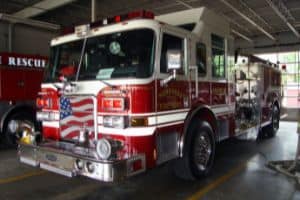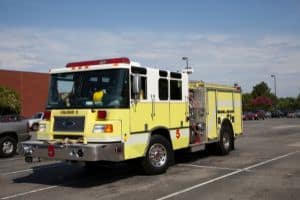If we told you to close your eyes and picture the color fire engine red, you could do so with ease, right? It’s a very distinct hue, albeit an informal one, but still highly recognizable. Have you ever stopped to wonder why such a bright shade of red has become associated with fire trucks? Why are they red instead of blue or yellow?

There are many theories on why fire trucks are red, from the hue being used as a warning sign to red being a way to stand out from the sea of dark-colored Ford cars common in the 1900s. Fire trucks are not always red though and might be bright yellow or green instead.
In this guide, we’ll unpack the theories on why fire trucks are that distinctive red hue as well as when fire trucks aren’t red at all. There is some interesting information on the way, so make sure you keep reading!
The Theories About Why Fire Trucks Are Red
As the intro should have indicated, there exists a myriad of theories about why fire trucks are the color they are, which is that bright fire engine red. Some are based on conjecture, others are more factual, but all are worth learning about.
Without further ado then, here are some of the theories about how fire engines got their most distinctive color.
To Stand Out
Around 1900, cars started appearing on the roads in large numbers. Most people owned the Model T Ford as designed by Henry Ford himself.
Today, cars come in at least several colors, but back then, there was far less variety. Henry Ford chose to paint the cars black because the color was supposedly low-cost. The black paint was also lauded for its durability.
Well, fire trucks couldn’t be a dark color if they wanted to be a distinct presence on the road, so the story goes that the fire departments at the time chose a color like red so no one could miss a fire truck compared to all those Model Ts.
To Look Expensive
Another theory that is also said to have originated at the same time is that fire departments wanted a red paint job for fire engines because that color costs the most to produce at the time. Thus, that would have signaled to any passersby that a fire engine was quite the commodity.
To Signal Warning
All colors have traits and emotions associated with them. Color psychology is an area that examines the human relationship with colors and the impact that hues can have on our mood.
According to color psychology, what does a hue like red represent? Red is an intense color associated with power, passion, energy, and action. It draws attention and can be provocative.
Many people see it and associate red with danger or warning. That’s further exemplified every time we’re on the road.
A red light means to stop, and a red traffic sign is designed to grab your attention swiftly. Red fire trucks can have the same result, indicating that danger is afoot.
If the color doesn’t give it away, then certainly the loud sirens and the flashing lights would.
Why Are Fire Trucks Other Colors Besides Red?
As iconic as the color fine engine red is, did you know that not all fire trucks are red? Not even close!
According to a 2019 article in FireRescue1, if you look at the light spectrum between red and violet, in low-light conditions, the one color that you would have the most difficult time seeing is red. Thus, it makes sense that fire departments would embrace other colors.

Let’s look at what those colors are and why they’re featured on fire engines.
Black
We’re far removed from the days of black Model Ts, so fire engines can reclaim this dark hue, and many have.
Although black might not be the most visible color at night, black is a great color for lessening glare by daylight.
A firefighter who’s behind the wheel or hopping out of the truck to combat fire cannot be distracted or even temporarily blinded by the glare, so black is a safe color for trucks.
Green
The American Psychological Association or APA says that lime-yellow fire trucks are an even safer hue than red.
The article in the link above cites a study from the U.S. Fire Administration or USFA done in 2009 that found that “fluorescent colors, including yellow-green and orange, are easiest to spot in daylight.”
The reason? The research that the APA looked at said that our eyes’ color-transmitting cones aren’t as efficient in the dark.
This can increase our ability to see some colors in darkness, and bright shades like green-yellow are at the top of that list.
Yellow
As far back as 1965, the Fire Brigade in Coventry, UK, and the Lanchester College of Technology, also in the UK, determined through research that yellow maintained its color under the glow of artificial streetlights better than red.
Plus, yellow stood out more in inclement weather and in “general road conditions.”
You’re likely to see small cities and suburbs use yellow fire engines, but bigger fire departments may take a page from their book!
Multicolored
It’s common to spot fire engines today that are more than one color, such as white with reflective gold stripes, yellow with white, or red with white or neon yellow.
The use of several colors could be a design choice, but it may also be that fire departments want to harness the advantages of several colors as illustrated throughout this article.
Fire engines are mostly red, but other hues such as bright green, yellow, orange, and white have become popular as well.
The logic is that some colors are easier to see in certain lighting conditions, especially low light.
However, a 2009 report published by the U.S. Fire Administration found that it was less about color and more about the presence of retroreflective strips that made a difference in how visible a fire engine is in the dark.
Thus, whether your local fire department has trucks that are red, white, blue, or another hue entirely, you can rest assured the trucks are safe on the road!
